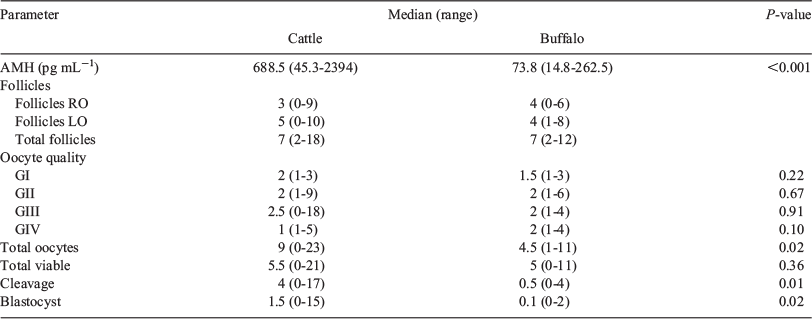68 Anti-Mullerian hormone levels in different bovine species and the relationship with in vitro embryo production
J. Berdugo A , A. Tarazona-Morales B , J. Echeverry-Zuluaga A , W. Cardona Maya C , A. López-Herrera A , G. Crudeli D , J. Konrad D and G. Espasandin DA Grupo de Biodiversidad y Genética Molecular-BIOGEM, Universidad Nacional de Colombia, Sede Medellin, Medellin, Antioquia, Colombia;
B Biogenesis, Universidad Nacional de Colombia, Sede Medellin, Medellin, Antioquia, Colombia;
C Grupo de Reproduccion.Universidad de Antioquia, Medellin, Antioquia, Colombia;
D IBRA, Universidad Nacional del Nordeste, Corrientes, Corrientes, Argentina
Reproduction, Fertility and Development 32(2) 159-160 https://doi.org/10.1071/RDv32n2Ab68
Published: 2 December 2019
Abstract
The development of markers for reproductive function has been a goal for the embryo production industry and reproductive biology as a method to improve success and increase the ability to explain reproductive phenomena. Cattle and buffalo are bovines that show different reproductive parameters raised in the same conditions. The aim of this work was to compare the results of the in vitro production of cows (Bos indicus) and buffalo (Bubalus bubalis) from animals kept under the same conditions of feeding and handling. This study was conducted in an Argentinian commercial herd of buffalo and cattle located in the province of Corrientes (−27.742859 latitude, −57.773611 longitude) during the breeding season of 2018 (March-May). Twenty animals of each species were used. Anti-Mullerian hormone (AMH) levels of each animal were determined using ELISA. Standardized protocols were used for oocyte aspiration, maturation, fertilisation, and culture of the embryos, and frozen semen of a single proven bull was used in each species. The numbers of follicles, oocytes, and embryos were recorded and analysed individually and grouped by species (Table 1). The normality of the data was evaluated with the D’Agostino and Shapiro-Wilk tests and the comparisons between species using the Mann-Whitney and ANOVA tests, and correlation analysis was performed using the Spearman test. Values are shown as median and range. A P-value <0.05 was considered statistically significant. The AMH levels of the cows were 688.5 pg mL−1 (45.3-2394) and the buffalo were 73.8 pg mL−1 (14.8-262.5); P < 0.001. Significant differences were found in the number of recovered oocytes of 9 (0-23) for cows vs. 4.5 (1-11) for buffalo (P > 0.05). There were no significant differences in the number of follicles and the quality of the oocytes. Significant differences were found in the number of oocytes cleaved of 4 (0-17) vs. 0.5 (0-4) and blastocysts per animal of 1.5 (0-15) vs. 0.1 (0-2) for cows and buffalo, respectively. The number of blastocysts in relation to the number of oocytes cleaved did not show statistical significance. In spite of the difference in the AMH levels and the embryo production parameters, which were lower in buffalo, no correlation was found between AMH and the parameters studied in both species. The results obtained here are confirmed by others in the literature. Levels of AMH as a marker for embryo production are not useful in cattle and buffalo and do not explain the differences observed, certainly AMH is a marker for quantity as the preserver of the ovarian reserve.

|


